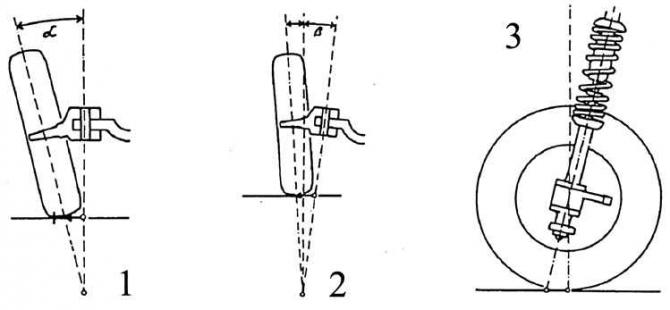Front wheel alignment

1. Collapse; 2. The transverse tilt of the kingpin; 3. Longitudinal inclination of the kingpin back
Toe-in refers to the lateral distance of the wheels from each other. Toe-in means that the wheels at midpoint height are closer together at the front than at the rear. Negative toe means that the front wheels are slightly further apart at the front than at the rear. The VW T4 has a positive convergence.
The camber and lateral tilt of the kingpin reduces the transmission of shocks from road irregularities to the steering and provides the least possible friction when negotiating turns.
Camber is the angle a, the angle of deviation of the wheel plane from the vertical. Thus, the front wheels are tilted. With positive camber, for example, at the point of contact of the wheels with the ground closer to each other than at the top. VW T4 has positive camber.
The convergence and collapse of the VW T4 vary depending on the load.
The transverse inclination of the kingpin is the angle b between the rotary axis of the steering knuckle and the vertical at the point of contact of the wheel with the supporting surface, relative to the longitudinal axis of the machine.
Due to the camber angle and the angle of the transverse inclination of the kingpin, the points of contact of the wheels with the road surface are close to the axis of the steering knuckle. This achieves a small, so-called break-in shoulder. The smaller the break-in arm, the easier the steering stroke. Even impacts from the road surface affect the steering lever system significantly less.
Kingpin pitch is the angle between the steering axis of the steering knuckle and the vertical at the point of inclination of the wheel with the supporting surface, relative to the transverse axis of the machine.
The longitudinal inclination of the kingpin significantly affects the output of the front wheels on a straight line. Too little kingpin tilt causes the steering wheel to not return enough to the center position after cornering or contributes to its deviation from the direct direction on flat roads.
Verification conditions:
- prescribed tire pressure;
- flat, horizontal surface when measuring;
- empty machine: unladen, with spare wheel, machine jack and full tank;
- the car is thoroughly sprung;
- steering adjusted;
- absence of unacceptable gaps in the system of steering levers;
- absence of unacceptable gaps in the wheel suspension.

Visitor comments